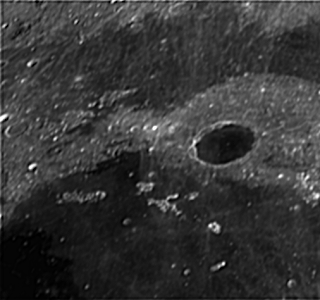 |
Bad Collimation
The Moon, Mare Imbrium, Plato's Crater and the Montes Alpes
300 mm aperture, f/10, SCT, no filter, no guiding, no AO,
Lumenera Skynyx 2.0, Registax 6, 6/14/2011, 9:33 PM EST
©Billy Vazquez @ VAO, Webster, NY |
The Moon is full on the night sky and last night from my observatory (VAO), I was put to the task to give the finishing touches to the collimation process. If you recall, from the M24 blog, my SCT is in dire need of collimation. With the help of Pempro Collimation, the Advanced CT Collimator from HOTECH and MetaGuide I can say that the telescope is nearly perfect collimated and ready for science runs. To the right we see an image of the Moon taken before I finish the collimation process. I capture 50 seconds of uncompressed AVI video with my Lumenera Skynyx 2.0 camera and processed it with Registax 6 to get the single stacked image you see. As you can tell from the image it looks all blurry, but you can see where the crater is and where Monte Alpes strech.
Next, I finish the collimation of my telescope with MetaGuide using Vega as a my reference star. The results of my collimation are seen now to the right on the second image of the same area of the Moon. It is quite obvious, that there is an increase on the amount of detailed capture on the second image. The reason, is that the optics are now nearly perfect aligned. Which is what I have been working to achieve all along.
 |
Good Collimation
The Moon, Mare Imbrium, Plato's Crater and the Montes Alpes
300 mm aperture, f/10, SCT, no filter, no guiding, no AO,
Lumenera Skynyx 2.0, Registax 6, 6/14/2011, 11:05 PM EST
©Billy Vazquez @ VAO, Webster, NY |
So my next question was, how good or bad was the "seeing" last night? The Earth atmosphere is an important factor for ground based observations, specially at low altitudes. Webster, NY is approx 465 feet above sea level. Not Manua Kea, Hawaii or La Palma, Canary Islands by a long shot. Still the question remains, how was the seeing? Can we do some type of test? Yes we can! I took another image of the moon this time, by using a TeleVue Powermate 2.5x. It increases the magnification of the image at the cost of flux (light intensity). For the technically savvy, it increases the f ratio of my telescope to f/25.
So why didn't I do this from the very beginning?
 |
The Moon, J. Herschel, Anaximander and Pythagoras Craters
300 mm aperture, f/25, SCT, no filter, no guiding, no AO,
Lumenera Skynyx 2.0, Registax 6, false color,
6/14/2011 12:09 PM EST ©Billy Vazquez @ VAO, Webster, NY |
The devil is in the details. Magnification of a signal comes at a cost of 2 things(mainly): decreased intensity and noise magnification. What noise? Ah yes, that is what we call all the undesired information in our image. In this case the worst offender is our planet's atmosphere. Still you see to your right an image of the Pythagoras crater and its surrounding neighborhood. You can see the shadow cast by the sun on the craters and the peculiar mountain like structure right smacked in the middle of the crater.
So what was I "fussing" about noise and atmosphere? The fuss is just that... lots of fuzzy and blurry details. The cause, the Earth atmosphere. The ideal location to image a celestial object is right above us, what astronomers call, the zenith. Unfortunately, I lack the technology to reposition the Moon to where I want to. Therefore, I image the Moon at its current location in the sky which is just above 20 degrees above the horizon, hardly the place you want to image. That is because a telescope has to go through a lot more atmosphere at lower altitudes than straight up at 90 degrees. Above there should be a video to demonstrate the effect of atmosphere last night.



No comments:
Post a Comment